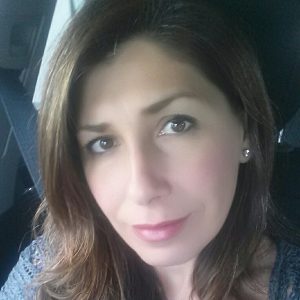By Diana Kupershmit
She had done it a thousand times before. When Emma was younger, she would slowly and carefully roll her body down the two steps of our sunken living room, from the foyer of our apartment. But as she got older, she evolved into scooting down on her bottom, with some semblance of graded control. It was a sight to see. Her four foot, seventy-five pound, lanky frame propelled itself by pushing off the floor with the back of her hands while simultaneously pumping her legs, in what appeared to me as a painfully uncomfortable movement, much like a caterpillar. She never did take to the hand splints that were custom-made for her when she was a little girl, to keep her wrists straight, and to prevent the contractures, that partly defined her life. Even as a small child, she was not going to be restrained and somehow always managed to remove the limiting splints—using her teeth to pull apart the velcro. A veritable Houdini. I marveled at her determination to get to where she wanted to go, with all of her physical limitations, as she would lower her diapered tush, first one step and then the other, bouncing and closing her eyes in anticipation of the not so soft landing.
From the corner of my eye I watched, as she rhythmically made her way to the couch where was sitting—attempting to go unnoticed as I would try to sneak in yet another episode of the Housewives of NY, or Orange County, or Beverly Hills or Atlanta—my one guilty pleasure. Emma would determinedly pause at my feet, reach for the remote control sitting next to me on the couch and place it matter of factly into my hand, and without skipping a beat, turn her head to look at the television in expectation. And even though I always knew how this story ended, I would make an unenthusiastic effort at redirecting her from her goal by placing the remote control behind my back. There was no dissuading her. Survival was the name of the game for Emma—from the day she was born. Precisely the reason she learned to pull herself up on the couch by planting her forearms and elbows into the cushion of the couch and with nothing less than sheer superhuman strength, throw her body up while pivoting it 180 degrees, so that she could land with aplomb on her padded behind next to me. The next movement involved her reaching for the remote control behind my back, retrieving it, and triumphantly and with a deliberate gesture, placing it in my hand once again so that I could comply with her wordless command to change the channel to Sesame Street. It was an impressive battle of wills and one that I invariably lost—secretly happy that I did.
Emma was our “special needs” baby. Our first child, who surprised everyone with her rare genetic make-up that left her non-ambulatory, non-verbal and with a host of medical issues—ensuring others would buzz around her with extra love and concern. Which was fine with her, because there was nothing that Emma delighted in more than an enthralled audience. Emma was not to have lived more than a year, according to the doctors, but by her eighteenth birthday it was safe to say that she had triumphantly proven them wrong.
Though Emma couldn’t speak, she bellowed volumes with her body. She made certain that her gestures and facial expressions would not be misconstrued. Her demands were made silently but with great cinematic flair, not unlike those of the silent pictures, and if you were clever enough to understand her particular brand of genius, she would reward you with a vigorous nodding of the head and a kiss she’d “blow” by putting her lips together and affecting a distinct popping sound.
When I think of Emma, the word softness comes to mind. Milky white softness of skin that rarely saw the sun long enough to do damage. This may have accounted for the fact that at 18 years of age, she looked like a mere babe with skin as supple as a newborn’s.
Her face was round with perpetually full cheeks. Her small eyes, spaced a bit far apart, left room for a nose that showed little 
Whatever fullness she overcompensated for in her cheeks, she was missing from her less than full lips and because she was low tone and floppy throughout, they took on a downturned cast, so that she appeared sad when at rest. Before Emma came along, I often heard my mother joke that thin-lipped people were mean. Emma was of course, a testament to the opposite of that being true.
Because her lips were mostly parted, drool was a constant companion to her chin and left her lips wet and shiny. I didn’t mind this a bit and relished kissing her glimmering lips, tasting her innocent sweetness. This always drew criticism from her father who worried that I would pass on a dormant virus or infection that I may have unknowingly harbored in my body, to Emma’s already compromised immune system.
Her limbs appeared not to have belonged to her, always in motion as if on their own—absent the ability to wield any modicum of control over them. Her arms appeared to be too long for her body and when I asked her for a hug, she would fling them over you with the best estimation, so as to land them on your shoulders. Being less than fluid in her movements, she reminded me of a darling baby ape. And her wrists—perpetually bent and folded into themselves, supported her soft body frame as she rested on the back of her hands.
In contrast to her bony arms, her hands were the epitome of softness—delicate, round pillows of cloudy softness. With no visible evidence of knuckles, you only knew that they existed when she rapped the back of her hands on her table tray in imitation of me. Her fingers ended in ladylike fingernails that would have looked great in a manicure if she were to ever appreciate or allow one. Sometimes I would take my wedding ring off and pull it down over her ring finger, imagining her a healthy young woman with prospects of marriage. She would immediately lift her hand to eye level, twist her wrist briskly to the left and to the right, as if admiring the ring’s beauty, laugh her silent laugh and proceed to remove it with her lips.
Emma’s lower extremities mirrored her arms—thin and spindly, they failed to cooperate in the way that they were designed to serve others. From very early on, Emma sported plastic foot orthotics, that supported her legs from just below her knees to the tips of her toes. To my eyes, they appeared like some medieval torture device, all straps, buckles and velcro. She wore them all day and could only remove them in the evening before bed. There was a time in the very beginning, when she was younger and they held the false promise of preventing degenerative regression, that she had to wear them at night as well. I just didn’t have the heart to do that to her—force her into the limiting hard constraints of the unwieldy plastic encasing her functionless legs even in sleep. As it was, she was a prisoner in her rebellious body during waking hours. I couldn’t justify the continued torture of the braces when her body needed to rest–so I freed her. In my mind, comfort trumped function and utilitarianism.
With her golden halo of curls, her angelic flawless skin and her softness of body, Emma evoked for me the images of the cherubs painted onto chapel ceilings by the Raphaels and the Rubens of Renaissance times. At once I would recall a story my high school Humanities professor told the class about Paul Rubens. Rubens was a prolific figure both artistically and in his personal life. He fathered eight children. The story goes that he was once asked by a friend or fellow painter, why the cherubs he painted were so beautiful but the children he fathered were so unattractive. To this, Rubens replied, “Because I create my cherubs in the light of day and my children in the dark of night, so I don’t see what Im doing.” I always loved this story—imagining Emma adorning the masterpieces in her Angelic form.
Though Emma was deceptively cherubic-looking, she was no serene wallflower. Rather, she was prone to constant motion. When sitting on the couch or laying on the floor, her hands were preoccupied with flipping the pages of her magazines with a great flurry of determination and purpose. It was a self-stimulating act that served some sensory need that only she understood. When handed a magazine, she would turn it and place it on her lap in such a way that she could grab the pages and flip them towards her in a quick, serious motion. It had to be done just so. If the magazine was delivered incorrectly, she would re-position it to satisfy her own personal order.
When magazines weren’t readily available, Emma made an art of chewing on one of her many bibs. Because she craved the oral stimulation that she missed out on by not being able to eat by mouth, Emma became expert at maneuvering her bib masterfully—moving it from dry spot to dry spot until the bib was thoroughly drenched. At that point, she handed you the bib with a grand gesture, as if she were offering you some coveted prize, then make the exchange by grabbing the new, dry bib out of your hand with a brisk motion, as if to say “it’s about time you came to your senses.”
I could watch her for hours. She was art in motion—a piece of music played in grandiose staccato. She appeared to possess a purity and a lightness of being that I could only dream of feeling. She lived in the enviable immediacy of the moment, always.

Diana Kupershmit is a social worker, photographer and mother. She is currently working on a memoir about life with her special needs daughter, Emma.



I see your heart glowing beautiful mama. Emma is blessed to have you. She is love.
Wow. Lost for words. Beautifully written Diana.